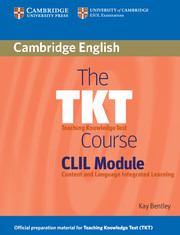Unit 9 - Materials selection and adaptation
Published online by Cambridge University Press: 27 September 2023
Summary
How can we choose materials and how can we adapt them for CLIL?
CLIL materials need to show curriculum subjects presented in a non-native language very clearly. CLIL materials are usually different from materials found in ELT coursebooks. Language courses have materials which are often selected because of a grammar or functional syllabus and also because of a topic. Topics are usually chosen to present and practise grammar or a set of functions. CLIL materials, however, are selected because of the subject content, for example, mathematics, art, history. The language needed to support the subject is then considered. Materials can be translated from the L1 curriculum, taken from native speaker coursebooks, downloaded from the Internet or made by teachers.
Look at these texts about history from three different sources: 1 an ELT coursebook 2 a native speaker website 3 a CLIL coursebook and read the list of differences.
Key concepts
In CLIL, learners study a curricular subject or a topic area from that subject which is usually in the L1 curriculum. Learners become knowledgeable about the subject in the target language and develop skills needed for that subject. Materials therefore need to include skills particular to the subject and they need to offer progression. The table shows examples of CLIL subjects and some skills the subject aims to develop. In all subject materials, we should give learners opportunities to achieve and enjoy learning.
What should we ask about CLIL materials?
Are the materials:
appropriate for the age of the learners and the stage of learning?
fit for purpose? Do they match the learning outcomes?
linked to CLIL aims? Do they consider content, communication, cognition, culture?
progressive in subject content, in language, in cognitive demands, in task demands?
supportive? Do they have word banks, language frames and visuals?
varied in skills, tasks, interaction?
collaborative, challenging and achievable?
motivating and complete?
- Type
- Chapter
- Information
- The TKT Course CLIL Module , pp. 50 - 56Publisher: Cambridge University PressPrint publication year: 2010



